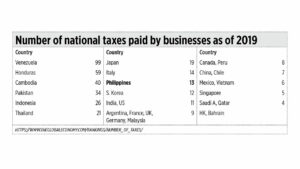“Leftists propose ‘redistribution of wealth’ because of their inability to create it.
“My dream is that when I finish my public service, Argentina is the freest country in the world.”
— Argentina President Javier Milei
The massive fiscal reforms in Argentina are good templates for countries suffering from sustained high budget deficits annually leading to high borrowing, high interest rates, and high interest payments. I went to Buenos Aires in December to attend the Tholos Forum 2024 along with fellow leaders of free market think tanks and country taxpayers’ associations.
Here are the key fiscal reforms enacted in Argentina.
1. President Javier Milei reduced the number of ministries from 19 to eight. Under former President Alberto Fernandez (President from December 2019 to December 2023), there were 21 ministries, later reduced to 19. Milei initially cut the 19 to nine plus the Chief of Cabinet. He later further cut it to only eight ministries plus Chief of Cabinet. The remaining eight ministries are: Economy; Foreign Affairs International Trade and Worship; Defense; Security; Health; Justice; Human Capital; and, Deregulation and State Transformation.
2. Milei and Minister of Deregulation Sturzenegger announced on Jan. 1 that new state employees can be hired only if three existing employees are fired within the same department for each new employee that is hired.
3. Milei announced on Dec. 11 that he will abolish 90% of taxes, not revenues, and keep only at most six taxes. My friends at the Argentine Asociacion de Contribuyentes (AAC, Argentina Taxpayers Association) said that since 2019 they had been proposing this abolition of 90% of taxes that contribute little to actual revenue collections. AAC is close to President Milei, and the latter has acted on the AAC proposal.
As of 2019, the Philippines has 13 types of business taxes while Argentina has nine. But there are many local taxes — provincial, city/municipal, barangay/village taxes — on top of national taxes and they can distort the overall tax and business environment.
Inspired by the fantastic fiscal reforms in Argentina, here is my 10-item fiscal wish list for 2025-2026.
1. That revenues reach P4.9 trillion in 2025 and P5.4 trillion in 2026. The Development Budget Coordination Committee’s (DBCC) medium-term revenue targets as of Dec. 2, 2024 were P4.6 trillion in 2025 and P5.1 trillion in 2026. The reason for my hopefulness is that there were significant increases in recent revenues — P3.55 trillion in 2022, P3.82 trillion in 2023, P4.1 trillion in January-November 2024, and likely to reach P4.4 trillion for the full year of 2024, or a P600 billion increase from 2023-2024. And I am only projecting an increase of P500 billion/year in 2025 and 2026.
2. That non-tax revenues, in particular, reach P650 billion in 2025 and P700 billion in 2026. Non-tax revenues were only P324 billion in 2022, P394 billion in 2023, P555 billion in January-November 2024, and likely at P607 billion for full year 2024. Finance Secretary Ralph G. Recto is largely responsible for this big increase because he increased the mandatory remittance share of government-owned and -controlled corporations (GOCCs) from 50% to 75% of their earnings.
3. That disbursements be controlled to only P6.2 trillion in 2025 and P6.4 trillion in 2026. The DBCC disbursement targets are P6.2 trillion in 2025 and P6.5 trillion in 2026. Actual disbursements were P5.16 trillion in 2022, P5.34 trillion in 2023, P5.28 trillion in January-November 2024, and will likely be P6 trillion in full year 2024. Budget Secretary Amenah F. Pangandaman will be more inspired to push the National Government Rightsizing Program (NGRP) bill to institutionalize spending control and, by extension, deficit control.
4. That the budget deficit be no more than P1.3 trillion in 2025 and not more than P1 trillion in 2026. The DBCC target deficits are P1.54 trillion in 2025 and P1.48 trillion in 2026. The actual deficit was P1.61 trillion in 2022, P1.51 trillion in 2023, P1.18 trillion in January-November 2024, and will likely be P1.58 trillion in full year 2024.
5. That financing or borrowings decline to P1.3 trillion in 2025 and P1 trillion in 2026. Financing was P1.97 trillion in 2022, P2.07 trillion in 2023, P1.24 trillion in January-November 2024, and will likely be P1.4 trillion in full year 2024. In the absence of any crisis — economic or virus — the government should focus on reducing the debt stock and hence, reducing interest rates and interest payments.
6. That interest rates for government 10-year bonds decline from around 6% in 2024, to 4.5% in 2025 and 4% in 2026. As public borrowings decline, the “crowding out” effect of government competing with private borrowings will simmer and so interest rates will go down.
7. That interest payment declines to P600 billion in 2025 and P500 billion in 2026. Interest payments were P503 billion in 2022, P628 billion in 2023, P705 billion in January-November 2024, and are likely to reach P760 billion in full year 2024. Reduced borrowing and reduced interest rates will contribute to this scenario.
8. That the inflation rate stabilizes at 2.5% to 3% in 2025 and be below 2.5% in 2026. The inflation rate was 5.8% in 2022, 6% in 2023, and 3.2% in January-November 2024.
9. That the overall GDP growth be 6.5% in 2025 and 2026. It was 7.6% in 2022, then lowered to 5.5% in 2023 and 5.8% in Q1-Q3 of 2024. Lower inflation and interest rates will improve consumer and investor confidence in the country, pulling up household consumption (about 73% of GDP) and capital formation or investment (about 25% of GDP) and hence, overall GDP.
10. That the endless, no time-table subsidies decline significantly. The government should focus on the rule of law, the public should focus more on personal and parental responsibility in running their own lives.
Bienvenido S. Oplas, Jr. is the president of Bienvenido S. Oplas, Jr. Research Consultancy Services, and Minimal Government Thinkers. He is an international fellow of the Tholos Foundation.






